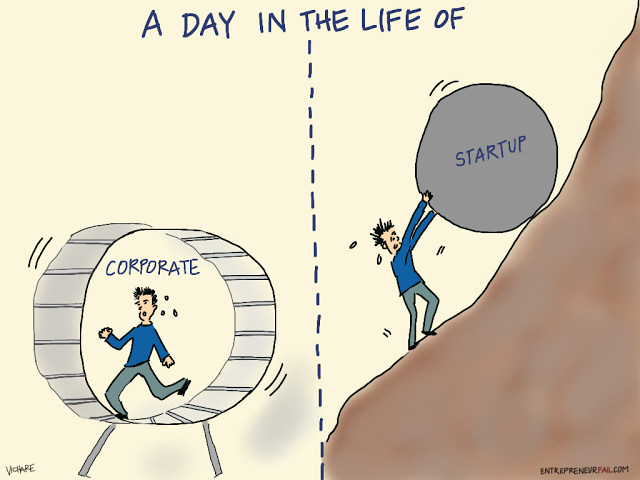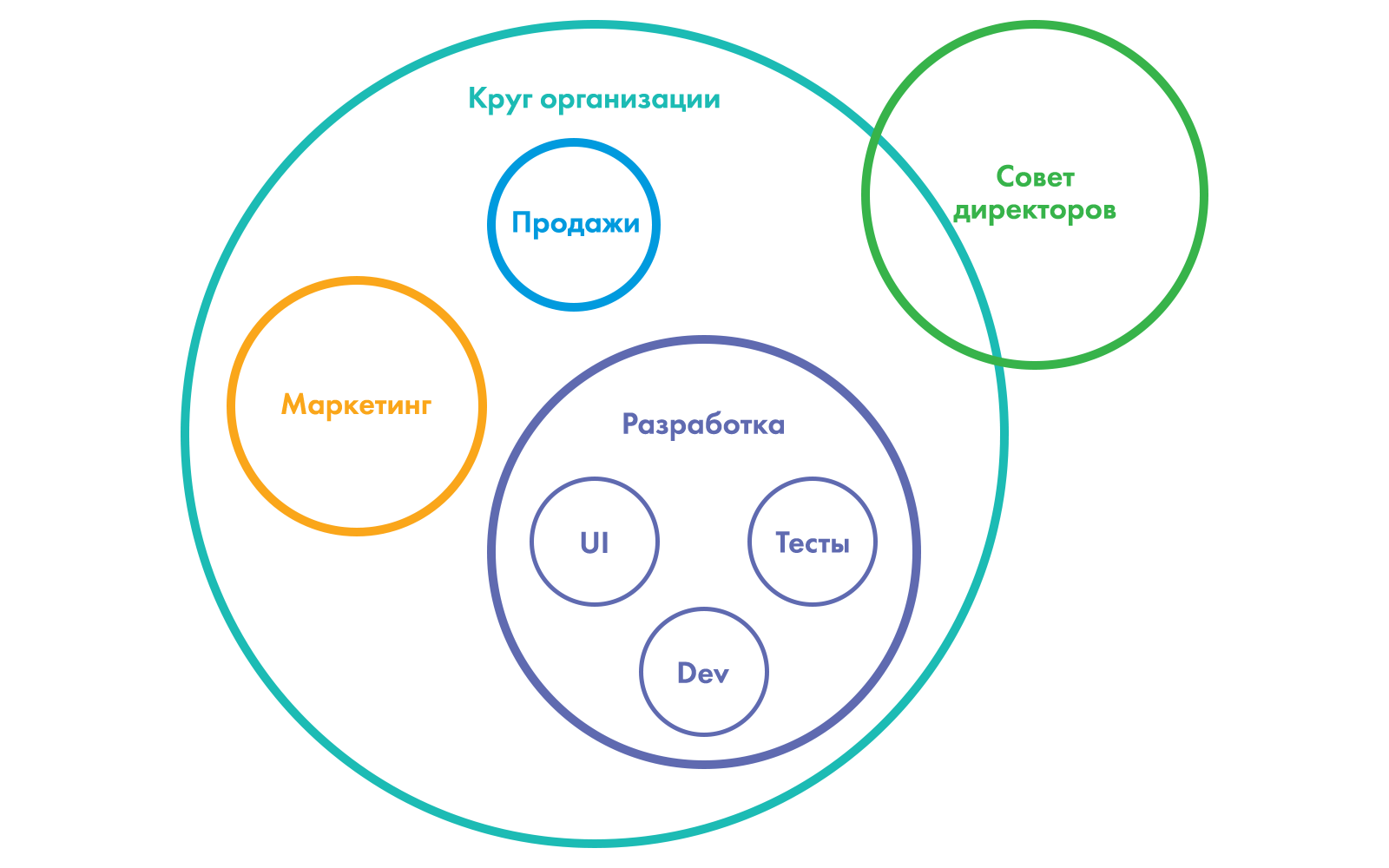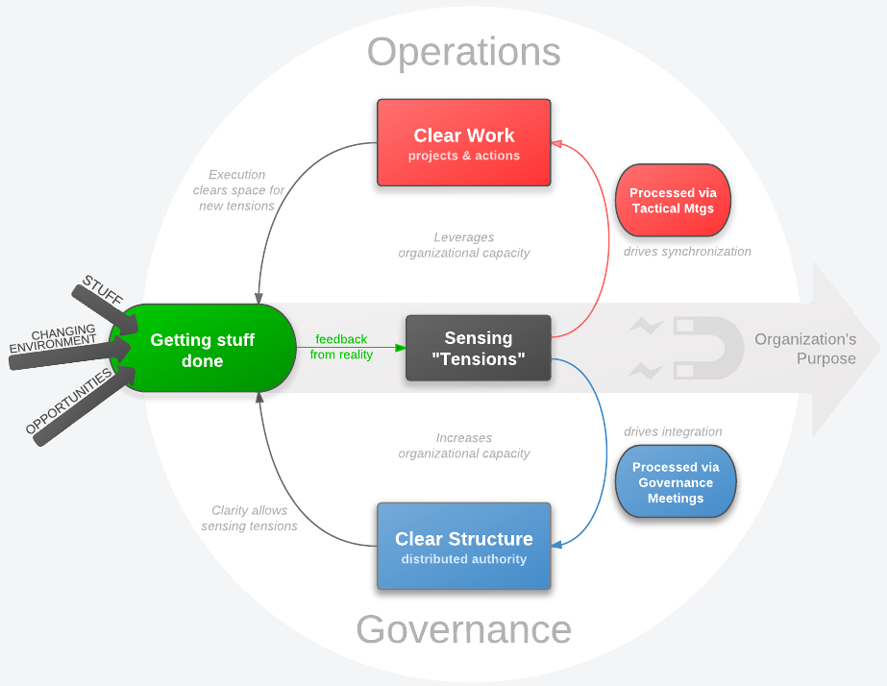What is holacracy and why you don't need it
Holacracy will soon become a new fashionable buzzword in the world of IT business , which start-ups, agile and ling have become in their time. Already, an incredible hyip has risen in Silicon Valley: Medium -level companies, Zappos and Airbnb are introducing the Constitution 4.0 with might and main; Soon the trend will reach our northern latitudes and cause even more misunderstanding due to translation difficulties. Let's get ahead of events and try to figure out what holacracy is, where it came from and what benefits it can bring.

The button serves entrepreneurs, and so it turns out that we always need to be a little ahead to offer the coolest solutions. Therefore, we love to try everything new. We started experiments with holacracy a few months ago: we stuffed the first bumps, talked to US consultants, felt the first improvements, and continue to implement and study. In the first article we will tell you about the basic things that are important for understanding, and in the following we will share our own experiences and answer popular questions.
IT companies are conditionally divided into two camps: large corporations with a level of bureaucracy close to classic business, and young startups with a flat organizational structure, for whom mobility and informality in decision making is the only way to survive. Of course, this is an extreme degree, and there are many intermediate states, but for a better understanding, consider the problems of these particular organizational structures.
')

The main problems of large companies are bureaucracy and strict hierarchy. In this situation, employees are limited by the job description and the will of the manager, over which is another pair of managers, the CEO and the board of directors. Any decisions are made either for an incredibly long time or bypassing the rules and regulations. The rights and obligations of each employee are secured by the job description, which rarely hassomething in common with reality. This leads to absolute opacity and a dilution of responsibility - there is no understanding of who is doing what and from whom for what to ask. The CEO motivates the CTO, the CTO calls the project manager to the carpet, he blames the product-manager for everything , then the team leaders and ordinary developers will get it. Everyone is to blame, and who will fix this is not clear.
In startups with a flat structure, everything is different. As long as you have a dozen employees recruited on the principle of “burning eyes” and “willingness to work for food,” you don’t need a hierarchy at all, a division of responsibility andany rules. Your task is to work 146 hours a day and do everything that comes handy. Transparency is achieved through daily meetings and continuous collaboration. The pluralism of opinions is negated by the number and general idea, less often - by the firm will of the founding visionary , decisions are made quickly and immediately go to work. You have a chance to stay forever in this beautiful moment, but sometimes it is time to grow. A flat structure in a company with 50 employees is worse than any tyranny.
If you want to keep freedom and mobility, without slipping into continuous discussions, postalping-pong , compromise solutions or other extremes, holacracy can throw a couple of useful ideas. Let's say at once, holacracy is not a silver bullet, it gives almost all questions one answer: “It depends.” So what is it all about?
The creator of holacracy, Brian Robertson, faced these problems when he left a large company and founded his own business. Working in a corporation prevented self-realization, and it became increasingly difficult to manage a growing startup. Brian began experimenting with different approaches, changing the structure of organization and distribution of power. All these researches have pushed him on the everyday metaphor. While reading, look at the picture and present this good-natured speaker:

Anyblack-black city has a black-black mayor or a city manager who solves global problems, someone manages certain districts, there is a house management and several more levels of hierarchy. At the same time, the mayor, the head of the district administration, the head of the Ministry of Internal Affairs and the house manager cannot give orders to the tenant of a particular apartment. They cannot indicate where to work, how much to wake up and how many times a day to brush their teeth. The person himself decides to buy furniture and eliminates problems in his own space segment: he repairs the plumbing, he sets up his life, he earns money. There are certain limits of possibilities: your decisions and actions should not interfere with other people and damage the city property, or the benefits of their use should be higher than the damage done.
There are also processes that allow you to take the problem out of your apartment: go to your neighbors for salt, ask the house management to repair the elevator, convince the district administration to patch the asphalt or challenge the city budget at a meeting in the city hall. In an ideal spherical city, a self-organizing distributed power structure appears, which makes it possible to influence the development of the system and its individual parts, while maintaining personal responsibility for their own well-being. Moreover, the larger the city, the higher the personal effectiveness of each unit - the district, house, apartment, person. Why not apply this approach in business?

From this powerful metaphor, the idea of holacracy was born. The company is a city, the CEO is the mayor, the departments are areas, inside the departments there are houses and apartments. All play according to the same rules, are endowed with equal rights and duties and can influence each other only indirectly.
Holacratia is a way to decentralize power, which allows you to build a hierarchy (holarchy) in such a way that each employee can influence the life of a company and has full power within its role and the expectations placed on it. Holacracy is not managed by management, but by the overall goal of the company, a transparent process, expectations and metrics. At the same time, formally, you have no bosses, but anyone in the company has the right to know what you are doing and how effectively you do your work.
With the introduction of holacracy, the company is divided into circles. It looks a bit silly and, at first glance, changes only the plates on the doors: departments and departments become “circles”, employees turn into “roles”, and the organization becomes one huge “anchor” circle, which includes all circles and roles. It looks like this:

However, behind the screen is a big idea. Let's look at the standard hierarchical model in which the directorate extends its sharp tentacles, overthrowing the will of departments and specific people through middle-level vassals:

In holacracy, everything looks a little different: the tentacles of power are in every circle, be it a super circle or a sub circle. These tentacles even have special names:lead link and rap link (otherwise, the lead link and the representative):

A lead-link - top-down tentacle is a specially trained role that is charged with several responsibilities: to deliver information from the outer to the inner circle, determine the roles needed within this circle, if necessary, combine the roles in the subcircle, assign (and remove) roles to certain employees, except when the appointment is determined by the election. If not all the roles in a circle are staffed with the right people, the lead link takes on the role of this role. The lead link itself is assigned by the outer circle. There are lead links in superclubs and subcircles. If in a nutshell: a lead link is a person who acts inside the circle on behalf of the outer circle, a sort of manager with a knocked down crown.
Rep-link - tentacle bottom-up - a role that represents the interests of the inner circle in the outer. He accumulates questions, problems and suggestions of the circle and brings them up for discussion in the external circle, for special management meetings (governance meetings). Rep-links do not become - representatives determine the circle itself by simple voting. Lead-link can not be even a rap-link (with one exception), otherwise the whole system will break. Rep-link should not behave like a trade union, promoting the interests of only its own circle, it must have a good understanding of the goals and objectives of the super circle and the whole company, otherwise the whole system will break. In other words, the rap-link is an ambassador of a circle;
It turns out that in a holarchy information does not fall from heaven to earth in the form of directives and does not move chaotically between all the participants in the process. Proposals, solutions and questions move freely along pre-laid paths and fall into the tenacious hands of those for whom they are important, and for those who are just interested. The holarchy is not directedupwards , but works both ways through ordered channels. In fact, the role of a manager is performed by a process that does not ask for money and does not apply to you biased.
And what is the role? This is a set of functions assigned to a person (if not to show off, then simply a position). By the way, the circle is also a role, just so extensive that one person can no longer fulfill it. The role has a kind of job description. The difference is one: this instruction is formed on the basis of the expectations and common goal of the company, and not from the desire to limit the rights and capabilities of the person. The same person can occupy different roles in one or several circles, and if he cannot cope with one of the roles, it is necessary to remove the person from this role, and not from everyone at once. Just like in life: you can be a postman, father, friend, cricketer and avid nudist. Moreover, if you are a bad father, you should be deprived of parental rights, but this should not affect the role of the postman, and will not limit the entrance to specialized beaches. However, if you perform each of the roles equally badly, only one thing remains - a hero who is oblivious :)

Is your brain still intact? Then let's figure out how the processes are arranged. If you carefully looked at the pictures, you noticed that holacracy actually has its own special hierarchy - a holarchy, which looks like a system of nested circles. However, the outer circle cannot influence how the work is done internally; it does not have the right to give direct instructions and manage resources (even the CEO cannot indicate to the ordinary SMMs that which cats better post on Twitter if the SMMs guys do their job). The only thing that the outer circle can manage is the expectations, metrics and the list of roles of its subcircle. If it is simpler, the outer circle can share ideas and proposals through alead link , but all operational activities are determined by people from the inner circle.
At each level of nesting there are tactical and managerial meetings. Tactical people from the circle share information, synchronize task status and plan a little. For example, ascrum meeting is a tactical meeting. At management meetings, key members of the circle discuss the problems of the circle, select representatives and solve other important tasks. It turns out something like an internal retrospective of the circle, which is held under very strict rules. The problems of the internal circle can be brought to the management meeting of the external through a rep-link , but only if the problem cannot be solved within the circle or it affects the whole company. There are also the roles of the facilitator, who oversees the constructiveness of all meetings, and the secretary, who appoints and records them.
Any problems in holacracy are called "tensions" (tensions). The default duty of any role is to eliminate them on its own or through management meetings, for which this model is even called“tension-driven” (driven by voltage). Golden rules of holacracy:

As you have already guessed, holacracy does not answer the most important questions: “What exactly needs to be done?” And “What decisions to make?”. It regulates the approach to the organization of processes, but does not set tasks and does not describe solutions. Holacratia is a business operating system that requires the installation of various applications. For example, applications for hiring employees, for planning, for logistics. Therefore, within the framework of holacracy, any fashionable practice can be applied: agile, ling, scrum, if only there was benefit.
Starting to apply holacracy, you abolish the power of managers and directors and distribute it among "places." This leads to an interesting side effect: leaders begin to stand out in circles. You no longer need to try to strengthen individuals - it is enough to strengthen the process once and everything will happen naturally. The CEO turns into a talking head, a visionary and defines the overall goals and values of the company. Dear CEO, do not worry, in your hands will remain the most powerful ability - to cancel the holacracy.
The tribal structure, which is formed in ordinary companies on top of the hierarchy, disappears. For example, when a secretaryhas intercourse of an extremely close nature, he plays preference with his boss and suddenly gains power and influence in the areas of business that are the most distant from his profession. That same power is evenly distributed and cannot be accumulated and used by one person to the detriment of another. Thus, connections do not destroy work, and work does not destroy connections.

Holacratia encourages breaking the rules if it does more good than damage. Everyone is free to do whatever they want, if it helps the company to grow. This is called "individual action."
Holacratia replaces personality with a role, but does not deny the personality itself. You can continue to go to work in shorts, scold your mother, bring a dogand drunken lecherous women to the office if you do your job well, meet the metrics and expectations and do not interfere with the rest. Following this, “personal facilitation” disappears. The trouble is not the developer Vasya, but the role and the process. This is demagogy, but it allows you to get rid of emotions and improve processes, instead of a witch hunt.
Holacratia is bureaucratic through and through: there is a whole set of rules, described in detail in the 30 pages of a special holacratic Constitution . It lists the main provisions, the organizational structure of the company, the management process, the work process and even the process of adopting the constitution itself. This small Talmud is constantly evolving (version 4.0 is already available), but the basic principles remain the same. The document itself is completely unreadable, there is even a simplified version for those who do not want to understand the avian language of juristic terms. In fact, this document is the pinnacle of holarchy.
At the same time, the creator of holacracy asserts that it cannot be applied in part - one must once and forever take an oath to the Constitution and set in motion. This, however, is not surprising, given that the only goal of HolacracyOne , created by Brian Robertson, is to plant holacracy through training and implementation. And that is why you absolutely do not need holacracy. The process of full implementation will break the brain worse than this article, takes a lot of time and effort that can be spent on business development. And most importantly, it is unlikely to lead to universal happiness. The button is fighting marasmus and bureaucracy, we know how much they hinder business and we believe that any decisions need to be made, guided by reason and a broad view of things.

However, some principles of holacracy can and should be applied in practice. It just so happened that Button became one of the first companies experimenting with holacracy in Russia (and certainly the first accounting company that has come to this) We hope you have a couple of weeks, and most importantly, the desire to read and understand this post, because that in the next we will move from words to deeds, share our own experience and tell you more about why we did not sign the Constitution with blood. And if the comments reveal a keen interest in sabzh, we will write a separate article about different roles, processes, meetings,cross-linking and other buzz words. Ask questions, it will help a lot.
Thanks for attention.
At leisure, you can read:
And at the same time other push-button articles about service and project management:

The button serves entrepreneurs, and so it turns out that we always need to be a little ahead to offer the coolest solutions. Therefore, we love to try everything new. We started experiments with holacracy a few months ago: we stuffed the first bumps, talked to US consultants, felt the first improvements, and continue to implement and study. In the first article we will tell you about the basic things that are important for understanding, and in the following we will share our own experiences and answer popular questions.
Big and small
')

The main problems of large companies are bureaucracy and strict hierarchy. In this situation, employees are limited by the job description and the will of the manager, over which is another pair of managers, the CEO and the board of directors. Any decisions are made either for an incredibly long time or bypassing the rules and regulations. The rights and obligations of each employee are secured by the job description, which rarely has
In startups with a flat structure, everything is different. As long as you have a dozen employees recruited on the principle of “burning eyes” and “willingness to work for food,” you don’t need a hierarchy at all, a division of responsibility and
If you want to keep freedom and mobility, without slipping into continuous discussions, postal
Sim City inside the company
The creator of holacracy, Brian Robertson, faced these problems when he left a large company and founded his own business. Working in a corporation prevented self-realization, and it became increasingly difficult to manage a growing startup. Brian began experimenting with different approaches, changing the structure of organization and distribution of power. All these researches have pushed him on the everyday metaphor. While reading, look at the picture and present this good-natured speaker:

Any
There are also processes that allow you to take the problem out of your apartment: go to your neighbors for salt, ask the house management to repair the elevator, convince the district administration to patch the asphalt or challenge the city budget at a meeting in the city hall. In an ideal spherical city, a self-organizing distributed power structure appears, which makes it possible to influence the development of the system and its individual parts, while maintaining personal responsibility for their own well-being. Moreover, the larger the city, the higher the personal effectiveness of each unit - the district, house, apartment, person. Why not apply this approach in business?

From this powerful metaphor, the idea of holacracy was born. The company is a city, the CEO is the mayor, the departments are areas, inside the departments there are houses and apartments. All play according to the same rules, are endowed with equal rights and duties and can influence each other only indirectly.
Ordered chaos or head around
Holacratia is a way to decentralize power, which allows you to build a hierarchy (holarchy) in such a way that each employee can influence the life of a company and has full power within its role and the expectations placed on it. Holacracy is not managed by management, but by the overall goal of the company, a transparent process, expectations and metrics. At the same time, formally, you have no bosses, but anyone in the company has the right to know what you are doing and how effectively you do your work.
With the introduction of holacracy, the company is divided into circles. It looks a bit silly and, at first glance, changes only the plates on the doors: departments and departments become “circles”, employees turn into “roles”, and the organization becomes one huge “anchor” circle, which includes all circles and roles. It looks like this:

However, behind the screen is a big idea. Let's look at the standard hierarchical model in which the directorate extends its sharp tentacles, overthrowing the will of departments and specific people through middle-level vassals:

In holacracy, everything looks a little different: the tentacles of power are in every circle, be it a super circle or a sub circle. These tentacles even have special names:

It turns out that in a holarchy information does not fall from heaven to earth in the form of directives and does not move chaotically between all the participants in the process. Proposals, solutions and questions move freely along pre-laid paths and fall into the tenacious hands of those for whom they are important, and for those who are just interested. The holarchy is not directed
The main role for everyone
And what is the role? This is a set of functions assigned to a person (if not to show off, then simply a position). By the way, the circle is also a role, just so extensive that one person can no longer fulfill it. The role has a kind of job description. The difference is one: this instruction is formed on the basis of the expectations and common goal of the company, and not from the desire to limit the rights and capabilities of the person. The same person can occupy different roles in one or several circles, and if he cannot cope with one of the roles, it is necessary to remove the person from this role, and not from everyone at once. Just like in life: you can be a postman, father, friend, cricketer and avid nudist. Moreover, if you are a bad father, you should be deprived of parental rights, but this should not affect the role of the postman, and will not limit the entrance to specialized beaches. However, if you perform each of the roles equally badly, only one thing remains - a hero who is oblivious :)

Is your brain still intact? Then let's figure out how the processes are arranged. If you carefully looked at the pictures, you noticed that holacracy actually has its own special hierarchy - a holarchy, which looks like a system of nested circles. However, the outer circle cannot influence how the work is done internally; it does not have the right to give direct instructions and manage resources (even the CEO cannot indicate to the ordinary SMMs that which cats better post on Twitter if the SMMs guys do their job). The only thing that the outer circle can manage is the expectations, metrics and the list of roles of its subcircle. If it is simpler, the outer circle can share ideas and proposals through a
At each level of nesting there are tactical and managerial meetings. Tactical people from the circle share information, synchronize task status and plan a little. For example, a
Any problems in holacracy are called "tensions" (tensions). The default duty of any role is to eliminate them on its own or through management meetings, for which this model is even called
- do not bring up the problem that concerns only you
- if you have found a solution to a common problem - bring it up to be used as a rule

As you have already guessed, holacracy does not answer the most important questions: “What exactly needs to be done?” And “What decisions to make?”. It regulates the approach to the organization of processes, but does not set tasks and does not describe solutions. Holacratia is a business operating system that requires the installation of various applications. For example, applications for hiring employees, for planning, for logistics. Therefore, within the framework of holacracy, any fashionable practice can be applied: agile, ling, scrum, if only there was benefit.
Cholacratia causes side effects
Starting to apply holacracy, you abolish the power of managers and directors and distribute it among "places." This leads to an interesting side effect: leaders begin to stand out in circles. You no longer need to try to strengthen individuals - it is enough to strengthen the process once and everything will happen naturally. The CEO turns into a talking head, a visionary and defines the overall goals and values of the company. Dear CEO, do not worry, in your hands will remain the most powerful ability - to cancel the holacracy.
The tribal structure, which is formed in ordinary companies on top of the hierarchy, disappears. For example, when a secretary

Holacratia encourages breaking the rules if it does more good than damage. Everyone is free to do whatever they want, if it helps the company to grow. This is called "individual action."
Holacratia replaces personality with a role, but does not deny the personality itself. You can continue to go to work in shorts, scold your mother, bring a dog
Bureaucracy 4.0 or why holacracy is not needed
Holacratia is bureaucratic through and through: there is a whole set of rules, described in detail in the 30 pages of a special holacratic Constitution . It lists the main provisions, the organizational structure of the company, the management process, the work process and even the process of adopting the constitution itself. This small Talmud is constantly evolving (version 4.0 is already available), but the basic principles remain the same. The document itself is completely unreadable, there is even a simplified version for those who do not want to understand the avian language of juristic terms. In fact, this document is the pinnacle of holarchy.
At the same time, the creator of holacracy asserts that it cannot be applied in part - one must once and forever take an oath to the Constitution and set in motion. This, however, is not surprising, given that the only goal of HolacracyOne , created by Brian Robertson, is to plant holacracy through training and implementation. And that is why you absolutely do not need holacracy. The process of full implementation will break the brain worse than this article, takes a lot of time and effort that can be spent on business development. And most importantly, it is unlikely to lead to universal happiness. The button is fighting marasmus and bureaucracy, we know how much they hinder business and we believe that any decisions need to be made, guided by reason and a broad view of things.

However, some principles of holacracy can and should be applied in practice. It just so happened that Button became one of the first companies experimenting with holacracy in Russia (and certainly the first accounting company that has come to this) We hope you have a couple of weeks, and most importantly, the desire to read and understand this post, because that in the next we will move from words to deeds, share our own experience and tell you more about why we did not sign the Constitution with blood. And if the comments reveal a keen interest in sabzh, we will write a separate article about different roles, processes, meetings,
Thanks for attention.
At leisure, you can read:
- Medium HolacracyOne blog
- the section " How it works " on their website
- or even watch a webinar from the maker of holacracy
And at the same time other push-button articles about service and project management:
Source: https://habr.com/ru/post/241327/
All Articles